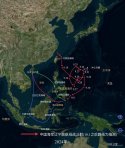Again, we saw what the Soviet Navy dreamed of.
No you didn't. Soviet Union had plenty of flaws but lack of ambition and vision was not one of them. For all its flaws Soviet Navy was also more competent in planning than it is commonly thought. USSR lacked naval tradition and was behind western maritime powers in terms of maintaining a modern naval industry. The fleet structure and ship classes that it built reflected those limitations as well as the strategic goals for the navy. Soviet Union was extremely practical in its strategic planning and more effective in that regard compared to Russia.
Soviet Union approved the construction of
only two Kuznetsov
heavy aviation cruisers and never intended for the ships to fulfill the role of an aircraft carrier because for that purpose it approved the construction of
Ulyanovsk-class nuclear-powered CATOBAR
aircraft carriers.
The first in class
Ulyanovsk was laid down in 1988 and when Russian FSSR caused the dissolution of the USSR the carrier was approximately half-way done. In comparison
Kuznetsov was laid down in 1982 and her sister ship
Riga was laid down in 1985.
Ulyanovsk was ordered upon completion of formal design stage in 1986.
Kuznetsov was a
second development of Kiev-class, after
Tallin from 1978, all of which had a specific role in protecting the "Bastion" against enemy submarines.
Kiev was an
ASW helicopter carrier with
flag facilities and
anti-ship cruise missiles with nuclear warheads for deterrence. This is why it was classified as a "heavy aviation cruiser" rather than "aircraft carrier".
Kuznetsov fulfilled the same role but was designed to carry Su-33 because Yak-38 proved to be a failure and the navy wanted to have greater radius of protection against
enemy ASW aircraft. The standard complement of
Kuznetsov was one squadron (18) of Su-33 and 24 helicopters of all types. It was used as an "aircraft carrier" only when it became a (failed) prop for Russia's global ambitions. It is simply not designed for that purpose and it doesn't perform well with that complement.
Ulyanovsk was intended as the first "proper" carrier although it was the second Soviet carrier design - the first attempt being made under Gorshkov in 1970s with
Orel-class. It took into consideration all the information gathered about operations of USN CVNs and was designed with two catapults and one ramp to support three squadrons of fighters and several AEW planes (Yak-44) as well as a squadron of ASW helicopters.
Kuznetsov was an interim class that would allow to introduce shipborne variants of Su-27 and MiG-29 into naval service. They would also replace the poorly performing
Moskva and
Leningrad in long range missions allowing for the two to remain in Black Sea/Eastern Med.
Which brings me to
Liaoning and
Shandong.
Both serve as interim measures as well as play the role of traditional aircraft carriers. I don't know how their design was modified from the original but they are not ships capable of effectively using the (
Kuznetsov's) maximum capability of 32 fixed-wing aircraft. Kuznetsov was initially designed with a catapult on its angled deck but once
Ulyanovsk was approved the design was changed to reduce cost and I am not sure if it could be easily upgraded with one e.g. an EM system. Without a catapult its usefulness in combat operations is severely limited. Soviet navy designed a ship for its very specific requirements which included also operations in a very specific geographic area. The design is not as flexible and capable as Russian propaganda claims.
This is possible in peacetime:
but in wartime that would immediately present a problem. Also the ranges indicated here are distorted by map projection. Since we know a little about Cold War operations in North Atlantic this should help to visualise it better:

The Philippines cover all of the GIUK gap and the movements in the previous image cover most of Norwegian Sea as well as half of North Atlantic.
These carriers will be invaluable as mobile airfields for when the airstrips on artificial islands are inaccessible. They may also provide some (limited) additional capability to a task force operating beyond the first chain but that's that. Considering the exposure of PLAN task forces to enemy submarines they would probably prove far more useful in their original intended role - as ASW assets - rather than as fixed-wing carriers. A squadron of fighters won't hurt but it won't do much more considering how clipped their wings are without catapults.
And that again puts into question many of the standard narratives that are circulating in the open. An "entusiast" who is more interested in the fantasy may refuse to acknowledge that a wooden hammer is not intended for iron nails but the people who build and use the wooden hammer every day at work know what they're doing.
Anyway, that's just me thinking aloud.




